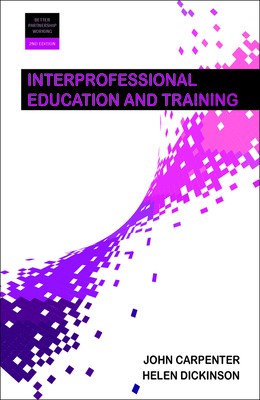
- We will send in 10–14 business days.
- Author: John Carpenter
- Publisher: Policy Press
- ISBN-10: 1447329805
- ISBN-13: 9781447329800
- Format: 13 x 20.1 x 3.6 cm, minkšti viršeliai
- Language: English
- SAVE -10% with code: EXTRA
Reviews
Description
The idea that professionals in health and social care should 'learn together to work together' in 'interprofessional education' (IPE) is not new. Nevertheless, interest in this concept has grown dramatically. By learning together, professions will better understand each other and value what others bring to the practice of collaboration. Through working together more effectively, the quality of care and outcomes for users will be improved, but what is the evidence to support this? How can effective and sustainable IPE programmes be designed and run? What theoretical perspectives are useful? How can programmes be evaluated? This essential guide provides a thorough introduction to IPE in health and social care. It examines the research on IPE in detail, providing much-needed practical advice. This second edition includes updates to research and policy internationally, examples of successful programmes and methods of evaluation, and provides readers with an essential set of IPE 'do's and don'ts'.
EXTRA 10 % discount with code: EXTRA
The promotion ends in 23d.09:38:26
The discount code is valid when purchasing from 10 €. Discounts do not stack.
- Author: John Carpenter
- Publisher: Policy Press
- ISBN-10: 1447329805
- ISBN-13: 9781447329800
- Format: 13 x 20.1 x 3.6 cm, minkšti viršeliai
- Language: English English
The idea that professionals in health and social care should 'learn together to work together' in 'interprofessional education' (IPE) is not new. Nevertheless, interest in this concept has grown dramatically. By learning together, professions will better understand each other and value what others bring to the practice of collaboration. Through working together more effectively, the quality of care and outcomes for users will be improved, but what is the evidence to support this? How can effective and sustainable IPE programmes be designed and run? What theoretical perspectives are useful? How can programmes be evaluated? This essential guide provides a thorough introduction to IPE in health and social care. It examines the research on IPE in detail, providing much-needed practical advice. This second edition includes updates to research and policy internationally, examples of successful programmes and methods of evaluation, and provides readers with an essential set of IPE 'do's and don'ts'.


Reviews